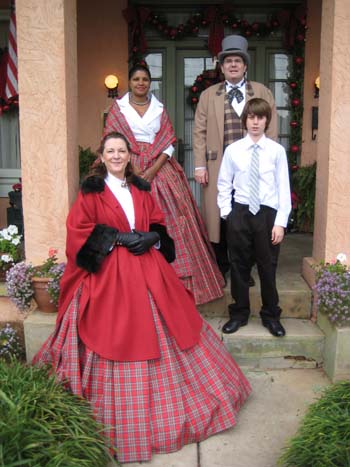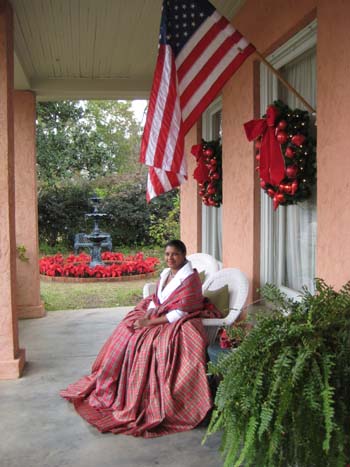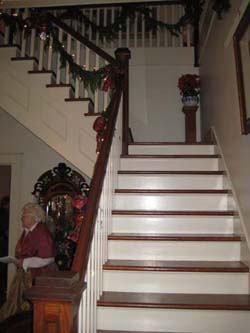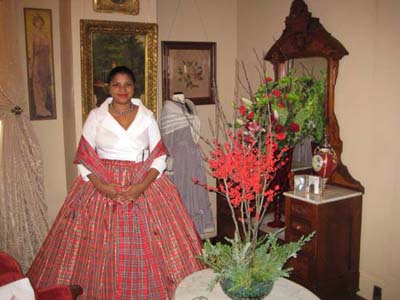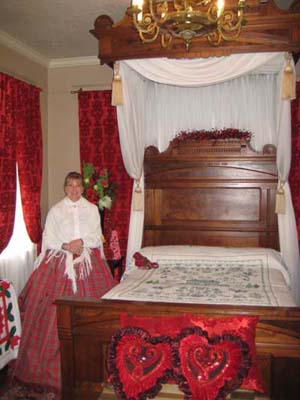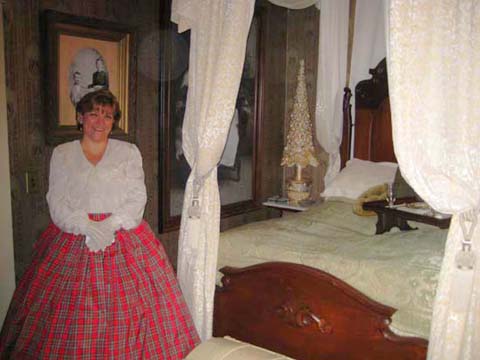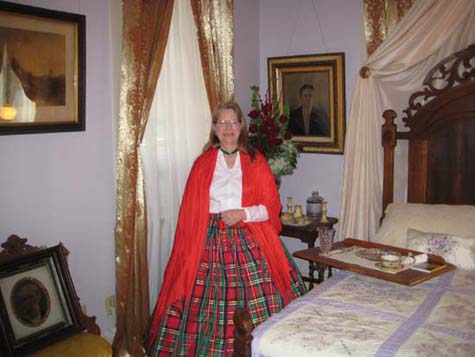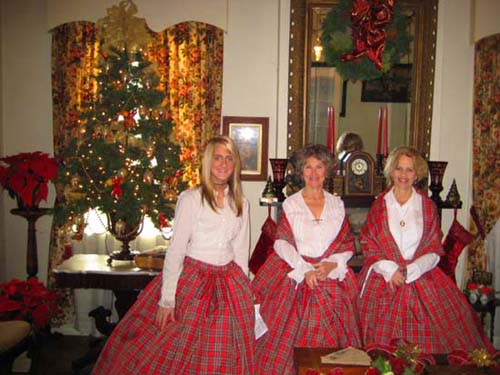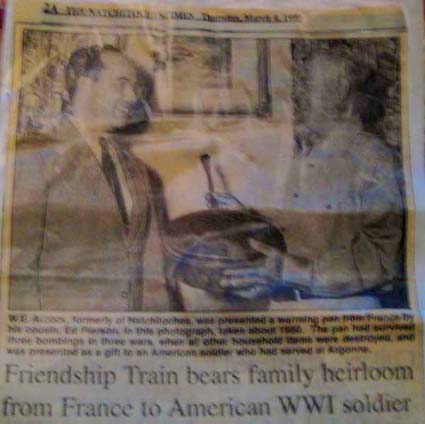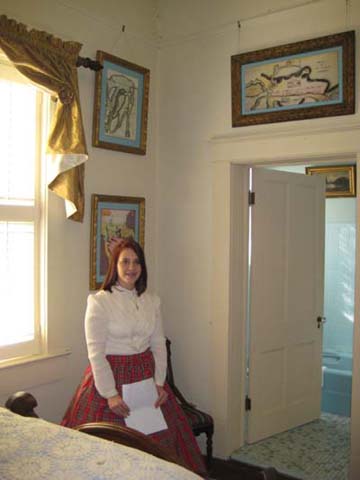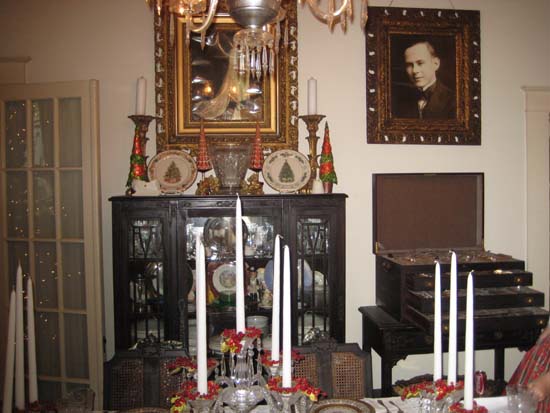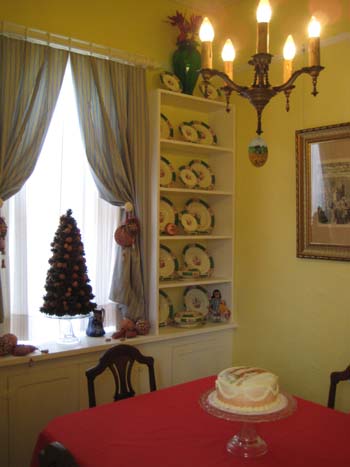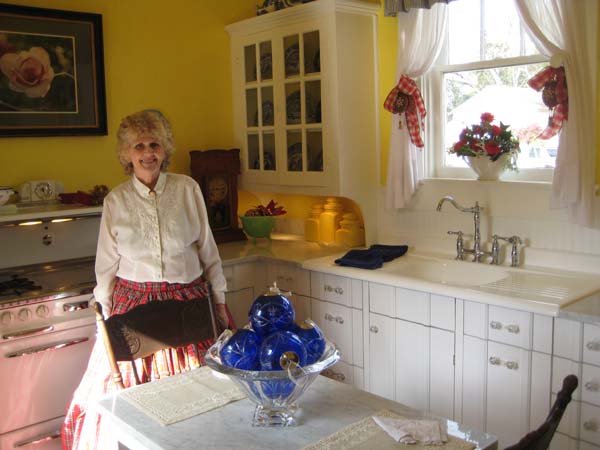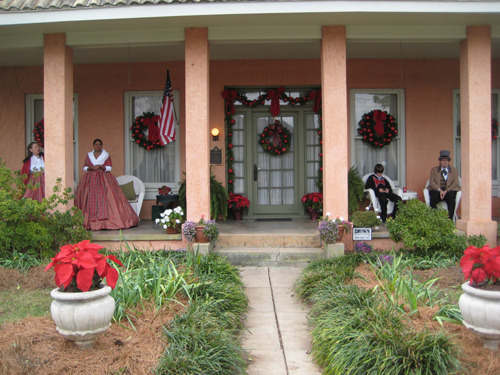
|
If you could not make it to Natchitoches this season, we'd like for you to be able to come along on a virtual tour of Soldini House. The house was full of ladies in hoop dresses and gentlemen in period attire, all conducting you first into the house and then through the various rooms.
Here on this virtual tour we can show you what you would have seen had you been able to join us an we can also supply the narrative that you would have heard. Though a pale imitation of an actual in-person tour, we hope you will enjoy this trip through Soldini House.
Be sure to come visit us during another of Natchitoches' special events, and if our home is open we will be pleased to welcome you. If you have a special interest in seeing Soldini House, please contact us using the link at the bottom of this page.
Now, enjoy your virtual tour!
The Front Verandah
|
Greeting you on the Verandah were: (front, left) Arleen Mayeux (Justin and Gary's neighbor and proprietor of the Jefferson House B&B), (rear, right) Rod Cathey (Gary's first cousin) and (front, right) Sam Welch (Justin's cousin and son of Lucia Marie Creighton). Helping out throughout the house was (rear, left) Melissa Robinson (friend of Justin and Gary and Tour Chairman of the Natchitoches Historic Society).
For your first encounter with the tour guides, they took the time to greet you with some information about the house and the tour.
Sam:
"Hello! I am Sam Welch, and I am the great-great-great-grandson of J.H. Williams, who bought this house in 1916 for his daughter, my great-great-grandmother. On behalf of our family, I would like to welcome you to Soldini House!"
Rod:
"This is the 164th Christmas that this home has looked forward to a visit from Santa Claus. This residence was designed by Anthonese Triscini and built in 1847 by Joseph Soldini as his own residence. It has been placed on the National Register of Historic Places along with six other structures designed and built by that team- including the Lemee House and the famous "Steel Magnolia" House next door. The United States Department of the Interior designated this home as "Pivotal" to Natchitoches being named only the second National Historic District by the United States Congress.
In the past 163 years, a great deal of history has passed by this verandah. You could have seen both Robert E. Lee and Ulysses S. Grant as they stopped in Natchitoches with their regiments, on their way to fight in the Mexican War.
In 1863, you could have witnessed the Union Army headed south in retreat after their defeat at the Battle of Mansfield. The Confederate Army was in hot pursuit, which may explain why the Union soldiers did not stop long enough to burn any of the town. Another reason given why Natchitoches was spared the torch is that General Grant had given specific orders not to burn Natchitoches because of the fond memories he had from when he had visited."
Sam:
"My great-grandmother told me that when she was a little girl, during the early days of the automobile, children in the home would start shouting the news when a car was heard coming down the road. All the children would run out of the house onto this verandah to cheer and wave as the strange, new "horseless carriages" drove by."
Arleen:
"In 1984, tracks were laid down on the street for the movie cameras to roll past in the filming of the movie "Steel Magnolias." One of Sam's cousins who often played on this porch, and an uncle who often sat here passing the time, were cast as extras in the film. You can see them early in the picture as a paperboy on a bike throws a paper into this yard, and the little girl runs to pick it up and bring it to the old man sitting here."
Rod:
"You will hear many more stories of the house and of the families that have called it home. And, there are a few secrets to learn, as well. We hope you enjoy your visit as you step back into an Old Natchitoches Christmas."
|
|
|
(Then the front door was opened and you were welcomed into Soldini House)
The Front Room (first floor, right, front)
 Kathlean Cathey Gayle Fitzhugh Hostesses for the Front Room |
(Gayle Fitzhugh)
"Merry Christmas! We are so glad you all are visiting with us today. The property Soldini House sits on was first owned by Anthonese Demeziere through a land grant from the United States in the early 1800s. Rue Demeziere, the street beside the house, is named after him. The property passed to the Greneaux family before being purchased by Joseph Soldini in 1847. Soldini, a master bricklayer, had moved from Austria to Natchitoches at the urging of his friend, the architect Anthonese Triscini.
Soldini became the most important builder in Natchitoches history. Seven residences that he built here in the historic district are on the National Register of Historic Places. They include the Steel Magnolia, Lemee, Levy-East, Mehwer-Brown, Laurcate, William and Mary, and Soldini Houses. This house was built of the finest materials: marble imported from Italy, hand-made bricks and cypress wood. All the exterior walls on the 1st floor are of double brick with stucco. The north and south walls are 14 inches thick, the east and west walls are 12 inches thick. All the interior walls on the 1st floor are also double brick with plaster. It is one of only two structures in Natchitoches that still retains its attached slave wing."
(Kathlean Cathey)
"The Soldini House passed to the Chaplin family for six dec ades, and then sold to the present family when J.H. Williams bought the structure in 1915. Today, the 5th generation of the family still owns the home, and you'll learn more about them in the Williams Parlor. The large mantle mirror is one of 2 mirrors in the house that were originally transported to Natchitoches from Georgia by ox wagon. They hang over Italian marble mantles that are original to the house. The ewers on the mantle were placed there in 1917. In each room you will see examples of rare flow blue china. This curio displays a polychrome flow blue set, one of the rarest sets in the collection. Above it, you will see the posters depicting this home on the Fall 2009 Tour. And below it is the poster of this Tour- the Christmas Tour you're on today. The center table is French. The very fine rosewood etagere is pre-Civil War. it displays a collection of Stffordshire figurines. The painting of Christ with the crown of thorns is believed to be the oldest painting and frame in the house. the bronze and crystal chandelier is from the 1800s.
This room has seen many joyous celebrations: 50th wedding anniversaries, weddings and even my mother's 100th birthday party. Today, we celebrate your visit with us during this holy season."
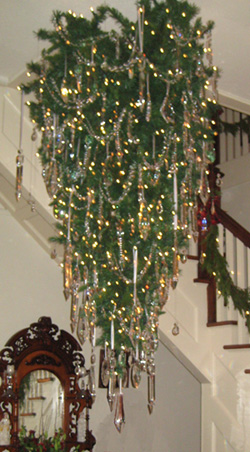
|
(Gayle Fitzhugh)
The upside-down tree that dominates this room is covered with over two thousand chandelier crystals. Some might think that upside-down trees are a modern trend among designers, but few realize that the earliest recorded history of a tree being used by Christians to celebrate Christmas tells us that the tree was hung upside-down from the ceiling. Trees had been used for millennia for the pagan celebration Saturnalia, also in December. To celebrate the winter solstice, Romans brought trees into their homes and decorated them with gold, silver and other trinkets. As these Roman pagans converted to Christianity, some scholars believe that they continued to celebrate the custom of decorating a tree, but turned it upside-down to differentiate themselves from the pagans. The tradition of upside-down trees continued for hundreds of years in parts of Poland and Germany."
(Kathlean Cathey)
"All the garland you see in the room is cedar. There are over 1000 fresh flowers in arrangements throughout the home for today's tour. These halls are decked! But that was not always the custom in America. Look at the print above the staircase. it titled "Christmas Eve." From the family's dress, this was in the Colonial era or early 1800s. We see the whole family gathered together around the fire. But we see not one Christmas decoration in the home. In early America, most homes celebrated Christmas as a private religious observance, and shunned any outward display of decoration or attempt to draw attention away from the true meaning of Christmas. Today, we find ways to celebrate the true meaning of Christmas through our decorations. In each room you will see a nativity- some over 70 years old. Also, each room displays antique Bibles. The Bible on the coffee table here is over 150 years old. It is opened to a beautiful image of the Nativity.
We hope you have a very merry Christmas!"
(From the Front Room, the tour continued up the stairs to the second floor.)
The Stairway and Upstairs Hall
|
Ascending the front room staircase pictured at left, you would turn at the landing and climb the second flight. At the top, in front of you and below a large painting in the style of Western realism, was a hunt table decorated for Christmas; it also sported a working early-Century telephone. On the right is the doorway to Bobo's Bedroom, and on the left the doorway to the Ashland Bedroom.
On your right, where the landing continues to the rear of the house, is probably one of Justin and Gary's favorite pieces of artwork, and you, too, will probably be quite taken with their Art Deco portrait of a woman.
As you come up and stand by the hunt table and
look towards the rear of the house.
There is a chandelier over the stairway and some large eclectic pieces of art on the walls. Also visible is the doorway to the Bienville Bedroom. The bathroom is at the rear of the house behind the Bienville Bedroom.
(The tour sequence for the second floor will now take you to the right at the top of the stairs and into Bobo's Bedroom.)
Bobo's Bedroom (second floor, left, front)
|
(Melissa Robinson)
"This is the smallest bedroom on the second floor. However, it was the one that Mrs. Alcock chose for herself. She made both of the pink magnolia needlepoints that you can see on the French bed. The desk, chair, clock, rugs and the lovely settee (that you can see at the end of the bed here) were all hers.
The photograph on the chair by the door was taken in the parlor below this room on Mr. & Mrs. Alcock's 50th wedding anniversary. Mrs. Alcock, active with Pilgrimage, were thought of as the "Grand Dames" of Natchitoches. Mrs. Alcock enjoyed weaving, as did many of the Williamses. She had her loom set up in the adjoining bedroom where she practiced her hobby.
In the early years of Pilgrimage, tour hostesses wore hoop skirts in the antebellum style. In later years, the APHN began calling their hostesses "Calico Belles," and the costumes were simple calico dresses with shawls.
This actual dress
by the antique American dresser is the one Mrs. Alcock wore when hostessing Pilgrimage. There is a small Nativity in this room that belonged to Mrs. Alcock; it was made by her daughter Lucia, who gave it to her as a present."
(From here, your tour continues towards the back of the house and another bedroom.)
The Red Bedroom (second floor, left, rear)
|
(Terri Itzig)
"When Soldini House was originally built, it had only two bedrooms upstairs with windows only on the north and south bagles. In the early 1920s, the family moved to their plantation home near Natchez. During this period, the family donated the use of the home to the First Baptist church for use as the parsonage for their pastor, Reverend Shultz. (Today, the chapel of the church is named after the Reverend.) During the preacher's tenure in the house, the family gave him permission to build out the roofline on the front of the house and install windows to increase the air circulation in his daughters' rooms.
In 1926, work began to build a full second floor on the house. That resulted in the four second-floor bedrooms and the bath you see today. When work was complete, the family moved from the plantation back to town, reclaiming the house from the pastor. Soon after the family moved back into the house, the stock market crashed, taking much of the family fortune with it. Thus began the Great Depression. During that time of economic distress, even the well-to-do families had to do things they were not used to doing to stay afloat financially. That was true for the Alcock family as well. During that time, this Red Bedroom was known as the "Children's Room." The three children shared this room, and the other rooms on this floor were rented out to college students. Two portraits of the one son, Walter, are on the wall. In his later years, he was the old uncle that was sitting on the veranda in the opening montage of the movie "Steel Magnolias."
Walter had three sisters. Edna Gloria died at age 4 during a plague of diphtheria. The other two sisters, Ruth Estelle and Lucia (who was born in the downstairs bedroom), have their portraits in this room, and Lucia's wedding dress on display as well. Lucia was married in front of the fireplace in the Front Room, and a picture on her wedding day in 1941 hangs in this room. For the season, the wedding portrait has been placed on the small rocking chair, where you can see both the portrait and the wedding dress. Ruth Estelle Normand inherited this house from her parents; she was Justin's grandmother.
The bathroom on this floor was one of the first indoor bathrooms in Natchitoches. Throughout their lives, Ruth Estelle and Lucia would tell how the other schoolchildren would make fun of them when word got out that they had an indoor bathroom. They were teased that they were going to die from the germs! It seems that, at the time, there was quite a belief that indoor bathrooms were less sanitary than outhouses and chamber pots! Some in Natchitoches were slow to accept the "modern" idea.
The half-tester bed is in the Eastlake style and came from a plantation near Melrose. The large religious print is of Noah making a sacrifice on Mount Ararat. An exceptional Flow Blue set sits on the marble top of the washstand; have a look at
all of these items."
(Now your tour will exit through the back of that bedroom, cross the hall and enter the Bienville Bedroom.)
The Bienville Bedroom (second floor, right, rear)
|
(Lauren Cathey)
"Welcome to the Bienville Bedroom. You have learned that when Natchitoches Parish began it included almost one-fourth of Louisiana. Gary's quadruple-great grandfather, Peter Franks, whose portrait hangs in this room, is believed to be the earliest settler in the area of Natchitoches Parish (which later became Bienville Parish). It is for him and that side of the family that this room is named. Portraits of Peter Franks and his wife, whose maiden name was Kemp hang in the corner. At the foot of the bed is the Kemp family trunk that has been in the family for six generations. Its contents include an old corset, eyeglasses, hatpins, a blue back speller and an example of an invitation to a funeral."
(Hilda Cathey)
"The most cherished item in the trunk is the Kemp family Bible with all the generations' births, deaths and marriages recorded in its pages. As was the custom of the day, the family often named their children after famous American leaders. The Bible records four George Washington Kemps, four Benjamin Franklin Kemps and two Thomas Jefferson Kemps.
Another important item in the trunk is the family portrait album. There are tintypes and photos on postcards; the oldest picture is actually on glass. Everyone loves the pictures of the children with their wonderful period costumes. Barbara took a moment to point out a portrait of her husband's grandparents (it hangs behind Hilda in the picture above), and a violin that belonged to her grandfather. It has a lion's head where the scroll usually is. Here are young Lauren and the violin."
(Barbara Cathey)
"There is a portrait here of my husband's grandparents. This violin was his grandfather's. There is a lion's head where the scroll usually is."
(Lauren Cathey)
"Look closely, he is sticking his red wooden tongue out at you as you play!"
(Barbara Cathey)
The bed, shown in the picture above, is attributed to Prudent Mallard, one of the most famous New Orleans furniture makers of the 1800s.
The armoire
is French, and the sofa is in the American Classical style from the 1840s. The empire table is a European piece. Barbara showed off the
holiday tree
that was decorated with fresh kumquats and oranges, grown in the garden here and picked just the day before. There are also lemon trees, loquat trees, and grapefruit in the garden, and some years we get over 500 lemons off of one tree."
(From here, your tour completes the second floor as you continue through towards the front of the house and the fourth and last bedroom.)
The Ashland Bedroom (second floor, right, front)
|
(Nobie Makar)
"Welcome to the Ashland Bedroom, so named because the ancestors pictured in this room were from the little community of Ashland, which is located on what is now the northern border of Natchitoches Parish. The very distinguished gentleman in the frame is Gary's double-great grandfather, Harrison Hathorne. He owned a large plantation outside of Ashland. He was instrumental in ending Reconstruction in Natchitoches and afterwards was a judge. His granddaughter and her granddaughter, Gary's mother (who lived to be 100 years old), are both pictured in this room. In this picture of one of the room's citrine chairs, you can see on the left wall a picture of Gary's mother in her Mardi Gras Ball gown, which she wore ever season for a great many years. Her personal bible, the Sullivan family Bible, has been in Gary's family for many generations."
(Marty McCain)
"
The Rococo Revival bed
is attributed to William McCraken, another noted New Orleans furniture maker of the 1800s. The center table is Irish; it has a tiger oak top, winged cherubs, dragons eating berries and reticulated legs going into a barley twist and ending in bun feet- quite a combination of elements. On the table is
a nativity made by Gary's mother.
The dresser
and the citrine chairs are Renaissance Revival, while the armoire is French. And
the trunk holds a little secret:
it is filled to the brim with Mardi Gras beads collected over decades."
(Back out in the second floor hall, you should descend the staircase and then cross to the left side of the house for the parlor.)
The Williams Parlor (first floor, left, front)
|
(Jennifer Adkins)
"Merry Christmas! I'm Jennifer Adkins, the great-great-granddaughter of J. H. Williams (Justin's great-great-grandfather), for whom this parlor is named. The parlor has his portrait and that of my great-great-grandmother, Mary Edna Milling Williams. He was one of the most prominent men in Louisiana in the late 1800s and early 1900s; it was said that he could ride his horse from his place in Winnfield, 40 miles away from here, all the way to Natchitoches without ever leaving his own property! When he passed away in 1935, his descendants divided 34 plantations. In 1900, he built Roselawn and moved the family to Natchitoches from Montgomery."
(Gloria Jean Normand)
"I'm Gloria Jean Normand, Jennifer's mother, and my great-grandfather purchased this house from the Chaplin family in 1916 and deeded it to his daughter, my grandmother, Henri D. Williams as an engagement present, and to settle her deceased mother's estate. We all called her Bobo. When my brother, her first grandchild, tried to say "MawMaw", i twould come out "Bobo", and the name stuck. Bobo married Walter Alcock and they moved into Soldini House. You will learn much more abou tthem in the Alcock Dining Room. We all remember Bobo and Grandaddy well, and are so grateful to have grown up in such a wonderful family and such a beautiful home. From my earliest memories, all Bobo's grandchildren would gather here on Christmas Eve, and we'd have our portrait taken. This room contains our picture from 1957. Bobo would use each year's picture of her grandchildren on her next year's Christmas cards.
Papa Williams also purchased the house next door for another of his daughters, my Great Aunt Ruth Pearson. There is a photo of her and Bobo in the photo over the etagere. Those two sisters lived the rest of their lives side by side in these houses. The barley twist etagere is a family piece that is believed to be the oldest piece of furniture in the house. A near identical etagere can be seein in one of the bedrooms at The Hermitage, the home of President Andrew Jackson. On the etagere here is a very unusual set of flow blue with rectangular platters and covered serving pieces. The seats on the balloon back chairs are upholstered in black horse hair.
The secretary in this room is also an old family piece believed to have been made in Louisiana, and it contains a set of hand-painted porcelain. The flame mahogany American Classical sofa and marble top table in the window are both from the period during which the house was built."
(Ariel Adkins)
"I am Ariel Adkins, and I am pleased to be here with my mother and grandmother today to welcome you to our family's home. In front of the nativity scene on
the table below the portraits of Walter and Bobo Alcock
you see five bibles. Family Bibles have long been treasured possessions in many families, particularly in the South. Of
these five Bibles,
the first belonged to my great-great-great-grandfather, J. H. Williams, the second is the bible of my great-great-grandmother, Bobo, the third belonged to my great-grandmother Ruth Estelle Alcock Normand. She inherited the house from her mother, Bobo. The fourth bible belongs to my Uncle Joe and the fifth to my cousin, Justin Normand, the house's current owner. Five generations of bibles. The other bible you should notice, under the Christmas tree in
this room,
is an even older Bible that goes back many, many generations. It is the Williams Family Bible. Notice that there are no presents under the tree. That's because once trees began to be set right-side-up to celebrate christmas, there were small trees on tables, and the gifts were on the tree. These Faberge-inspired ornaments actually open to allow you to pu tthe goodies inside. In the early Victorian period, gifts were often fruit, nuts, and other small items. It was an image of Queen Victoria in Godley's Ladies' Journal sitting with Prince Albert and her children beside a tree on a table that made Christmas trees a part of popular culture in America in the mid-Victorian period."
|
(Jennifer Adkins)
The boxwood garland in this room is draped in the style that was typical of the Victorian period, accentuating the crystal and bronze chandelier from the late 1800s. The mirror over the mantel matches the one in the Front Room; it was hung to lean out away from the wall in the old style. In the 1980s, the wire holding the top broke and the mirror crashed to the floor, taking the clock with it. The clock and frame broke into dozens of pieces and the thick old mirror shattered. My great grandmother wasn't home at the time, but the gas stove was on and it burned a good deal of the frame. After many years in storage, the clock and frame were professionally restored in Dallas, and both were put back onto this mantel where they belong. You can't tell either was ever damaged.
On
the coffee table
you see an assortment of boxes and writing slopes. Notice the
stack of old canceled checks.
These are the actual checks with which Papa Williams purchased the house by paying off the prior owner's debts.
Thank you for coming to see our home today. We hope you enjoy your visit. Now, please move on to the Map Room."
(At this point, your tour takes you out the back of the parlor into a bedroom called the Map Room.)
The Map Room (Downstairs Bedroom) (first floor, left, rear)
|
(Sydnie Threadgill)
"Welcome to the only bedroom on the first floor of Soldini House. We call it the Map Room because of the collection of maps displayed on its walls. There is a print of the earliest known map of Natchitoches where you can see that this area was originally a group of islands in the Red river. It shows the "Great Raft," the name given to the naturally-formed log jam that had rendered the river un-navigable from this point north for over 100 miles, well into what is now Arkansas. When Natchitoches founder, A. St. Denis, and his men sailed as far north on the river as they could, they landed on the banks at this very spot and were greeted by the Nakitosh Indian tribe that was camped here. He claimed the land for France, and his men built a fort just a short distance from here. Bobby DeBlieux, Natchitoches' foremost historian, believes that Soldini House sits mere feet from where the original walls of this old fort once were.
The large map by the bed shows all the plantations from Natchez to New Orleans prior to the Civil War.
The American bed and gentleman's dresser are in the Renaissance Revival Style. The piece above the bed that holds the fabric drape is called a Corona. Underneath this room's Christmas tree is a fine walnut deed box and antique Bible; the Nativity in this room has been used by the family since 1939. Have a look at all these items, and some of the room's maps. The tree is an example of an early artificial tree. The first artificial trees did not appear in the 1950s or 1960s, but rather a century prior to that. The sudden popularity of Christmas trees brought about by Queen Victoria meant that too many trees in English and German forests were being topped, thus devastating the life-giving lumber industry. Parliaments in both countries passed laws regulating the cutting of Christmas trees. Thus, a cottage industry arose in the mid-Victorian period- making artificial trees out of goose feathers- like the one in this room. It was common for the feathers to be dyed green with a red paper macee berry at the end of each branch.
When Soldini built the house, it had a full cellar the size of the footprint of the house, as was the custom in Austria, his native land. The only residences in Natchitoches that still have cellars are four structures that Soldini built- the Lemee House, the Steel Magnolia House, the Laureate House and this home. All these cellars have had problems with flooding since these structures are located so close to the river. The water level in Louisiana made it unwise to build cellar. In 1926, the Alcocks brought the field hands from the plantation to town during the winter months, and bucket by bucket they filled most of the cellar up to ground level with dirt. If you get under the house today, you can still see the tops of the brick archways that were doors between the cellar's rooms. The area below this room was the only part of the cellar that was retained. At the end of your tour you will learn a secret about what went on in the cellar in the 1920s.
Behind this room is the blue bathroom, added on to the house just prior to mid-century. As you pass through the blue bathroom, notice the white goose feather tree on the countertop. It was also common to leave the tree its natural white. Thank you for visiting with us today, and now please pass through the bath and small sun porch and into the Alcock Dining Room. Please watch your step as you enter and exit the bath!"
(You should now follow the hostess's instructions to arrive in the Alcock Dining room.)
The Alcock Dining Room (first floor, right, middle-front)
|
(Lucia Marie Creighton)
"Welcome to the Alcock Dining Room. You have learned that my great-great-grandfather, J. H. Williams, purchased the house in 1916. That same year, he deeded the house to my great-grandmother, Bobo, as part of her inheritance after her mother's death. The very next year, she married my great-grandfather, Walter Alcock, and they moved into the house. In the picture at left, you can see a portrait of her handsome groom (who we called "Granddaddy"), Bobo in her wedding dress. The actual 93-year-old wedding gown, train, veil and headdress were on display in one of the upstairs bedrooms. As a wedding present, the groom's parents, the Alcocks, seen in that portrait, gave the couple a bag of gold to purchase furniture for the house. The William and Mary dining room suite in this room was purchased with some of that gold. This furniture was placed here in 1917 and has remained here since. Almost all the other items in the room belonged to Bobo. The china and crystal laid on the table and in the cabinets all belonged to her, and the luncheon set in the built-in cabinet, used when serving refreshments at bridge parties, was also hers. Even the linens on the table have her monogram. The room looks much as it did 92 years ago.
Another wedding present, this time from the bride's family, was an enormous collection of silver. The pattern is Etruscan by Gorham. There are 12 place settings with 13 pieces per setting. Together with the 100+ serving pieces, the set is all stored in a huge mahogany case that Haley will opened up for you. Each piece of the flatware is monogrammed with her maiden initials. All of these items have been used for countless family meals and social events, in typical place settings.
On the table is a crochet tablecloth made by a family member when she was 91 years old. It was entered in the Louisiana State Fair and won first place. Many of the crocheted pieces throughout the house are her handiwork, including the many delicate crochet ornaments on the Christmas tree in this room. It was not until the late Victorian period that you would have seen a floor-to-ceiling tree like this. With the rise of the middle class during the Industrial Revolution, families had more money to spend. The gifts got larger. Now, they were wagons, rocking horses, dollies and bikes. So, the presents went on the floor under the tree, and the trees got larger.
On one wall is the Alcock family crest, and a slate clock sits on the mantel. The chandelier in this room came from the Front Room in 1985; until that year, the only lights in the room were the sconces over the buffet and such candles as were lit.
(Your tour will continue through the back of the dining room towards the breakfast room, kitchen and back door to the house.)
The Breakfast Room (first floor, right, middle-rear)
The Kitchen (first floor, right, rear)
|
(Mary Ann Normand)
"Merry Christmas! I am Mary Ann Normand, and the wing of the house that you have just entered contains the Breakfast Room, Kitchen and Pantry, and was originally an attached wing built to house the enslaved people that Soldini owned. This home and the Tante Hauppe House have the only two surviving examples of attached slave wings in the Historic District. Most of the enslaved people were housed in detached quarters that, over the years, have disappeared. In the courthouse records, you can see that Soldini paid property taxes on 15 enslaved people. We do no tknow how many lived in these quarters and how many may have been housed in separate outbuildings. But, those were the individuals that fired and laid the brick, hammered the nails and applied the plaster to build this structure and many of the important architectural treasures of Old Natchitoches. In the 1920s, these quarters were converted into the rooms you see today.
A wonderful set of china by the English maker "Booth" fills
the built-in cabinets.
The Christmas tree in this room was made by the owner of Soldini House almost 40 years ago. Over the door is a set of plates by Clementine Hunter. Notice the one on the left is of her famous "Christmas Angels". But what dominates the room is the bronze bust of Abraham Lincoln. It is made from the original mold of the cast of Lincoln's face the day he won the Republican nomination for President. It was aquired from the New York Historic Society which owns the original. Lincoln was six feet, four inches tall at a time when the average man was five feet six inches. The shelf was made such that his head is exact height it would be if he were standing with us here in this room. Just imagine how tall he would look if he had on his stovepipe hat. On the shelf is the bronze of Lincoln's right hand that was cast the same day he won the nomination. It was that hand that signed the Emancipation Proclamation, turning the people that lived in this room from property into citizens in the eyes of the law. Here you can see much of this Abraham Lincoln memorabilia.
In the 1800s the most popular publication in the country was Harper's Weekly. Here is an actual copy of the Christmas issue from December, 1864, the last year of the Civil War. Both the cover and the centerfold, seen in this frame, were by Thomas Nast, considered to be the father of American illustration. The cover of the publication is entitled "Christmas Morning". It shows a mother and father watching as their 7 children play with their presents. Santa left lots of them, even a sword, and US military cap and backpack for the boy. That is how it looked in many homes on Christmas morning in the North that year. But in the south it was a much different scene. The war was drawing to an end. The economy of the Confederacy was in shambles. The Confederate army, as well as the civilian population, was suffering from the tight blockade the North had on trade coming into Southern ports. In the South that year, the children were told that Santa was not going to be able to get through the blockade. The stocking went empty.
Both Nast and Harper's supported the Union cause. The centerfold illustration shows this well. In this extraordinary image entitled "The Union Christmas Dinner", President Lincoln stretches out his hand inviting those outside to join. If you look closely, you will see that on the backs of all the chairs are the names of the states. The empty chairs you see are the states that had left the Union. The other illustrations that surround the dinner all communicate a Union victory. There is the classic Victory holding out the olive branch to summon the vanquished. There is the Biblical "return of the prodigal son". The lower right corner says "Lay down your arms and you will be welcome." The center bottom shows a Christmas feast with everyone toasting the soldiers and sailors. But the most interesting is the illustration in the lower left. It shows Lee surrendering to Grant. Interesting when you consider that this was imagining an event that would not happen for another three months. Lee would surrender to Grant on April 9th of 1865. Lincoln would be assassinated five days later.
|
It would be over a century before the descendents of those that lived in this wing would begin to realize the fullness and promise of "emancipation". As you visit the beautiful homes on the tour today, remember the lives and work of those who actually built them and kept them running.
Merry Christmas to each of you. As you walk through the short hall from the Breakfast Room, past the pantry to the Kitchen, there are two very interesting watercolors depicting wash day and, apparently, picking cotton. The fact that the slaves look about as much like Hispanics as they do slaves seems odd, but the pictures are appropriate to the former purpose of this wing of the house.
As you move through the kitchen, please leave by the back door. You may begin to smell the spice tea and other refreshments outside on the patio. Please help yourselves and relax there. We have enjoyed very much having you tour our home."
(Your tour came to an end on the patio, where you had the opportunity to sample the refreshments and reflect on the history of this proud home.)





